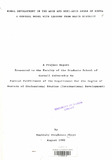| dc.description.abstract | Development of the Arid and Semi-Arid Lands (ASAL) of
Kenya is a key element in the nation's overall development
strategy. The ASAL region comprises some 80% of the total
land area in the country, but contains only about 25% of the
population. With the national population growing at 3.8%
per annum all available resources, including land, must be
developed to provide employment opportunities.
Substantial donor and Non-Governmental Organization
(NGO) funds have been spent in ASAL areas. The effort has
not achieved significant development due to the lack of
appropriate development strategy, programme design, and
coordination. A review .of the current donor and NGO
programmes in ASAL districts suggests a duplication of
projects among different programmes, lack of coordination in
planning and implementation, and inefficient use of scarce
technical manpower and capital resources.
The ASAL areas border five international countries.
Development of these areas is politically and economically
important to Kenya. Despite this need, national development
strategies have not focused specifically on ASAL development.
A two-tier General Model is proposed in which the
District Development Committee plans and implements
district-specific proJects, and the Provincial Planning
Committee plans and implements inter-district projects. The
model takes a macro perspective of sustainable regional
development. Individual projects and programmes for
implementing this strategy have to be designed separately.
District specific projects will be funded by sectoral
ministries of the government, the Rural Development Fund, the
European Economic Community Micro-Projects programme, the
ASAL Programme, the District Development Fund, NGOs, and
private organizations. The inter-district programmes will be
supported by the ministries of central government, donor
grants, technical assistance, and parastatal organizations.
A well coordinated development programme incorporating
all these financial resources, talents, and management
capabilities would enhance the development of human resource
capabilities, physical, social, and economic resources, and
institutional capacities for development, as well as
appropriate technology. The inter-district programmes would
provide physical and economic infrastructure such as roads,
telephones, electricity, regional water supplies, and
research institutions. The ensuing linkage between district
and inter-district projects would create opportunities for
trade within the ASAL regions, as well as with urban centers
in the core regions and the border countries.
The coordination envisaged in the proposed General Model
allows some degree of autonomy in project implementation
without sacrificing complementarity, consistency with
national policy, or efficient use of resources by the parties
involved. The Camel Herd Improvement Project ( see Appendix)
illustrates this.
Effective enforcement of cost sharing for services
offered by government institutions is crucial in sustaining
important public services in the ASAL region. Integration of
rural and urban development, and appropriate price policies,
are crucial to promotion of the informal sector and exchange
of goods between the ASAL region and major market centers in
the country.
Policy and development management strategies are
proposed to facilitate sustainable development in the ASAL
areas. These include coordination, through planning, of all
the development resources available to the ASAL in terms of
development finance, personnel, and research work. Immediate
research and documentation of potential industries like meat
processing, canning, and tourism should be given top
priority.
The General Model for Rural Development in Arid and
Semi-Arid Areas is applicable to any region with similar
ecological, socio-cultural, and economic characteristics. | en |

